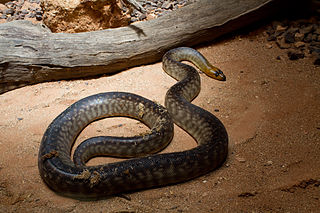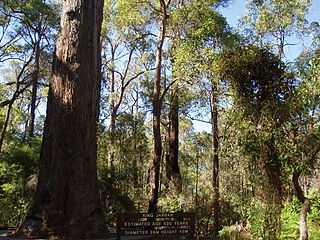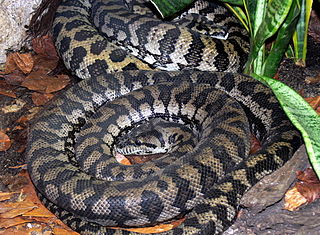
The numbat, also known as the noombat or walpurti, is an insectivorous marsupial. It is diurnal and its diet consists almost exclusively of termites.

Morelia is a genus of large snakes in the family Pythonidae found in Indonesia, New Guinea, and throughout Australia. Currently, up to eight species are recognized.

The green tree python, also known as the emerald green python, is a species of snake in the family Pythonidae. The species is native to New Guinea, some islands in Indonesia, and the Cape York Peninsula in Australia. First described by Hermann Schlegel in 1872, it was known for many years as Chondropython viridis. As its common name suggests, it is a bright green snake that can reach a total length of 2 m (6.6 ft) and a weight of 1.6 kg (3.5 lb), with females slightly larger and heavier than males. Living generally in trees, the green tree python mainly hunts and eats small reptiles and mammals. It is a popular pet, and numbers in the wild have suffered with large-scale smuggling of wild-caught green tree pythons in Indonesia. Despite this, the green tree python is rated as least concern on the IUCN Red List of endangered species.

Morelia spilota, commonly known as the carpet python, is a large snake of the family Pythonidae found in Australia, New Guinea, Bismarck Archipelago, and the northern Solomon Islands. Many subspecies are recognised; ITIS lists six, the Reptile Database six, and the IUCN eight.

The woma python, also known commonly as Ramsay's python, the sand python, and simply the woma, is a species of snake in the family Pythonidae, endemic to Australia. Once common throughout Western Australia, it has become critically endangered in some regions.

Morelia spilota cheynei, or the jungle carpet python, is a python subspecies found in the rainforests of Queensland, Australia.

Morelia bredli is a species of non-venomous snake in the family Pythonidae. The species is endemic to Australia. No subspecies are recognized. Its common names include Bredl's python, the Centralian python, the Centralian carpet python, the central Australian carpet python, Bredl's carpet python, the central Australian Bredl's carpet python, and the central Bredl's carpet python.

The amethystine python, also known as the scrub python or sanca permata in Indonesian, is a species of non-venomous snake in the family Pythonidae. The species is found in Indonesia and Papua New Guinea. Popular among reptile enthusiasts, and noted for its coloration and size, it is one of the largest snakes in the world, as measured either by length or weight, and is the largest native snake in Papua New Guinea. Until 2000, the larger S. kinghorni was generally considered a subspecies of S. amethistina, and this change of classification has still not been universally reflected in literature. Because of this issue, S. amethistina has often been described as the largest snake in Australia, but this is not accurate since under the current classification, this species does not occur in Australia.

The rough-scaled python is a large-scaled python species endemic to Australia. No subspecies are currently recognized.

The Oenpelli python or Oenpelli rock python is a species of large snake in the family Pythonidae. The species is endemic to the sandstone massif area of the western Arnhem Land region in the Northern Territory of Australia. There are no subspecies that are recognised as being valid. It has been called the rarest python in the world. Two notable characteristics of the species are the unusually large size of its eggs and its ability to change colour.

Jarrah Forest, also known as the Southwest Australia woodlands, is an interim Australian bioregion and ecoregion located in the south west of Western Australia. The name of the bioregion refers to the region's dominant plant community, jarrah forest – a tall, open forest in which the dominant overstory tree is jarrah.

Morelia spilota spilota is a subspecies of carpet python, popularly known as the diamond python. It is a medium to large snake, found in coastal areas and adjacent ranges of south-eastern Australia. It is the most southerly occurring python in the world and is found at higher altitudes than any other species of Australian python.

Morelia spilota metcalfei is a python subspecies found in Australia, commonly known as the Murray-Darling carpet python. The pythons are non-venomous snakes that constrict their prey. They grow up to 2.7m, but adults are usually around 2.4m. Colour varies depending on locality. Victorian Murray-Darlings are silver with solid black blotches and stripes; in New South Wales the silver becomes a light brown and the patterning has more of a black colour; South Australian MDs appear similar to those in New South Wales, though with patches of maroon. These pythons are semi-arboreal, typically inhabiting rocky outcrops, dry woodlands, riverine forests and flood plains. The threats to the snakes are people and other snakes.

Morelia spilota variegata, commonly known as Torresian carpet python, Darwin carpet python or northwestern carpet python, is a subspecies of python found in New Guinea and Australia, smaller than the nominate subspecies Morelia spilota spilota and has a more restricted geographic range.

Morelia spilota mcdowelli is a subspecies of Morelia spilota, commonly known as the carpet python, and is informally named the eastern, coastal, or McDowell's carpet python. The original description and name were published by Wells and Wellington in 1984. It occurs along the northeastern coast of Australia and in New Guinea.
The Warby-Ovens National Park is a national park located on the lands of the Bangerang clan of the Yorta Yorta Nation in the Hume region of Victoria, Australia near Killawara. The 14,655-hectare (36,210-acre) national park is situated approximately 10 kilometres (6.2 mi) west of Wangaratta and 240 kilometres (150 mi) northeast of Melbourne.
This article lists the various snakes of Australia which live in a wide variety of habitats around the country. The Australian scrub python is Australia's largest native snake.
Ophidascaris robertsi is a nematode usually parasitic in the carpet python. It is found in Australia and Papua New Guinea. Pythons serve as the typical hosts for Ophidascaris robertsi, which has an indirect life cycle. The adult parasites develop nodular masses in the oesophagus and stomach of carpet pythons and place a small piece of their anterior bodies into the nodules that protrude from the digestive mucosa. When endemic parasites like Ophidascaris robertsi infect local fauna, the pathological changes that follow are frequently self-limiting or do not result in illness.
















